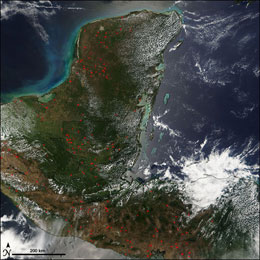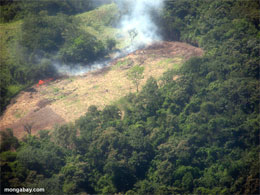Forest fires burn in Central America
Rhett A. Butler, mongabay.com
April 10, 2006
Hundreds of fires are burning across Central America according to NASA satellite images and reports from the ground. Fires have been detected in Mexico, Guatemala, El Salvador, Honduras, and Nicaragua.
Every spring farmers use fires to clear thousands of hectares of forest and scrub land for agricultural use. Burning vegetation not only makes land available for planting but releases enough nutrients to support vigorous crop growth for the season. However, as generally practiced, such techniques are associated with erosion and biodiversity loss.
These fires, combined with logging and other forms of development, have given Central America the highest deforestation rate of any region in the world over the past 15 years. Between 1990 and 2005, Central America lost 19 percent of its forest cover, or about 1.26 percent annually. Forest cover fell from 27,639,000 hectares to 22,411,000 ha in that time. Today, very little of Central America’s forest area can be classified as primary or virgin forest.
According to the UN, the countries with the highest rate of forest loss in Central America between 1990 and 2005 are Honduras (37.1 percent), Nicaragua (20.6 percent), El Salvador (20.5 percent), Guatemala (17.1 percent), and Costa Rica (6.7 percent). Despite this loss, Central America remains one of the most biodiverse regions on Earth. Several countries, including Costa Rica, Panama, and Honduras, are capitalizing on their biological wealth by promoting ecotourism.
This year, reports indicate that fires have burned a section of Tikal National Park in northern Guatemala, a UNESCO World Heritage site known for its ancient Maya ruins. In past years, several national parks have suffered damage from forest fires. For example, in 1998 fires burned more than 160,000 acres (65,000 hectares) of the Maya Biosphere Reserve in Guatemala.

